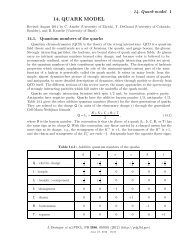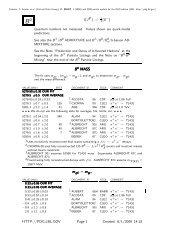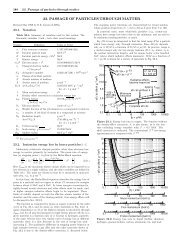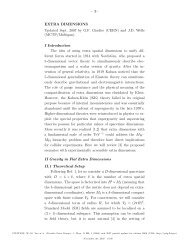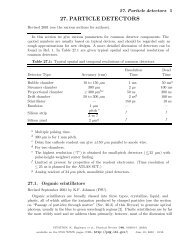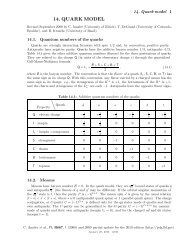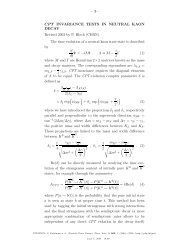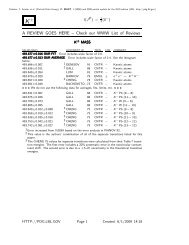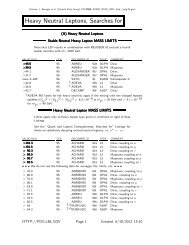Heavy Neutral Leptons, Searches for - Particle Data Group
Heavy Neutral Leptons, Searches for - Particle Data Group
Heavy Neutral Leptons, Searches for - Particle Data Group
Create successful ePaper yourself
Turn your PDF publications into a flip-book with our unique Google optimized e-Paper software.
Citation: D.E. Groom et al. (<strong>Particle</strong> <strong>Data</strong> <strong>Group</strong>), Eur. Phys. Jour. C15, 1 (2000) and 2001 partial update <strong>for</strong> edition 2002 (URL: http://pdg.lbl.gov)<strong>Heavy</strong> <strong>Neutral</strong> <strong>Leptons</strong>, <strong>Searches</strong> <strong>for</strong>(A) <strong>Heavy</strong> <strong>Neutral</strong> <strong>Leptons</strong>Stable <strong>Neutral</strong> <strong>Heavy</strong> Lepton MASS LIMITSNote that LEP results in combination with REUSSER 91 exclude a fourthstable neutrino with m< 2400 GeV.VALUE (GeV) CL% DOCUMENT ID TECN COMMENT>45.0 95 ABREU 92B DLPH Dirac>39.5 95 ABREU 92B DLPH Majorana>44.1 95 ALEXANDER 91F OPAL Dirac>37.2 95 ALEXANDER 91F OPAL Majorananone 3–100 90 SATO 91 KAM2 Kamiokande II>42.8 95 1 ADEVA 90S L3 Dirac>34.8 95 1 ADEVA 90S L3 Majorana>42.7 95 DECAMP 90F ALEP Dirac1 ADEVA 90S limits <strong>for</strong> the heavy neutrino apply if the mixing with the charged leptonssatisfies ∣ ∣ ∣ ∣ ∣ ∣∣U ∣2 1 j + U ∣2 2 j + U ∣2 3 j > 6.2×10 −8 at mL 0 =20GeVand> 5.1×10−10<strong>for</strong> m L 0 =40GeV. <strong>Heavy</strong> <strong>Neutral</strong> Lepton MASS LIMITSLimits apply only to heavy lepton type given in comment at right of dataListings. See review above <strong>for</strong> description of types.See the “Quark and Lepton Compositeness, <strong>Searches</strong> <strong>for</strong>” Listings <strong>for</strong>limits on radiatively decaying excited neutral leptons, i.e. ν ∗ → νγ.VALUE (GeV) CL% DOCUMENT ID TECN COMMENT>76.0 95 ABBIENDI 00I OPAL Majorana, coupling to e>88.0 95 ABBIENDI 00I OPAL Dirac, coupling to e>76.0 95 ABBIENDI 00I OPAL Majorana, coupling to µ>88.1 95 ABBIENDI 00I OPAL Dirac, coupling to µ>53.8 95 ABBIENDI 00I OPAL Majorana, coupling to τ>71.1 95 ABBIENDI 00I OPAL Dirac, coupling to τ>76.5 95 ABREU 99O DLPH Dirac coupling to e>79.5 95 ABREU 99O DLPH Dirac coupling to µ>60.5 95 ABREU 99O DLPH Dirac coupling to τ>92.4 95 ACCIARRI 99L L3 Dirac coupling to e>81.8 95 ACCIARRI 99L L3 Majorana coupling to e>93.3 95 ACCIARRI 99L L3 Dirac coupling to µ>84.1 95 ACCIARRI 99L L3 Majorana coupling to µ> 83.3 95 ACCIARRI 99L L3 Dirac coupling to τ> 73.5 95 ACCIARRI 99L L3 Majorana coupling to τ>63 95 2,3 BUSKULIC 96S ALEP Dirac>54.3 95 2,4 BUSKULIC 96S ALEP Majorana2 BUSKULIC 96S requires the decay length of the heavy lepton to be < 1 cm, limiting thesquare of the mixing angle ∣ ∣ Ulj ∣2 to 10 −10 .3 BUSKULIC 96S limit <strong>for</strong> mixing with τ. Massis>63.6 GeV <strong>for</strong> mixing with e or µ.4 BUSKULIC 96S limit <strong>for</strong> mixing with τ. Massis>55.2 GeV <strong>for</strong> mixing with e or µ.HTTP://PDG.LBL.GOV Page 1 Created: 5/23/2001 13:14
Citation: D.E. Groom et al. (<strong>Particle</strong> <strong>Data</strong> <strong>Group</strong>), Eur. Phys. Jour. C15, 1 (2000) and 2001 partial update <strong>for</strong> edition 2002 (URL: http://pdg.lbl.gov)Astrophysical Limits on Neutrino MASS <strong>for</strong> m ν> 1GeVVALUE (GeV) CL% DOCUMENT ID TECN COMMENT•••We do not use the following data <strong>for</strong> averages, fits, limits, etc. •••none 60–115 5 FARGION 95 ASTR Diracnone 9.2–2000 6 GARCIA 95 COSM Nucleosynthesisnone 26–4700 6 BECK 94 COSM Diracnone 6 – hundreds 7,8 MORI 92B KAM2 Dirac neutrinonone 24 – hundreds 7,8 MORI 92B KAM2 Majorana neutrinonone 10–2400 90 9 REUSSER 91 CNTR HPGe searchnone 3–100 90 SATO 91 KAM2 Kamiokande II10 ENQVIST 89 COSMnone 12–1400 6 CALDWELL 88 COSM Dirac νnone 4–16 90 6,7 OLIVE 88 COSM Dirac νnone 4–35 90 OLIVE 88 COSM Majorana ν>4.2 to 4.7 SREDNICKI 88 COSM Dirac ν>5.3 to 7.4 SREDNICKI 88 COSM Majorana νnone 20–1000 95 6 AHLEN 87 COSM Dirac ν>4.1 GRIEST 87 COSM Dirac ν5 FARGION 95 bound is sensitive to assumed ν concentration in the Galaxy. See alsoKONOPLICH 94.6 These results assume that neutrinos make up dark matter in the galactic halo.7 Limits based on annihilations in the sun and are due to an absence of high energyneutrinos detected in underground experiments.8 MORI 92B results assume that neutrinos make up dark matter in the galactic halo. Limitsbased on annihilations in earth are also given.9 REUSSER 91 uses existing ββ detector (see FISHER 89) to search <strong>for</strong> CDM Diracneutrinos.10 ENQVIST 89 argue that there is no cosmological upper bound on heavy neutrinos.(B) Other Bounds from Nuclear and <strong>Particle</strong> DecaysPeak and kink search testsLimits on ∣ ∣ Uex 2 as Function of m νxLimits on ∣ ∣U ex∣ ∣ 2 as function of mνjVALUE CL% DOCUMENT ID TECN COMMENT
Citation: D.E. Groom et al. (<strong>Particle</strong> <strong>Data</strong> <strong>Group</strong>), Eur. Phys. Jour. C15, 1 (2000) and 2001 partial update <strong>for</strong> edition 2002 (URL: http://pdg.lbl.gov)
Citation: D.E. Groom et al. (<strong>Particle</strong> <strong>Data</strong> <strong>Group</strong>), Eur. Phys. Jour. C15, 1 (2000) and 2001 partial update <strong>for</strong> edition 2002 (URL: http://pdg.lbl.gov)15 HOLZSCHUH 00 use an iron-free β spectrometer to measure the 35 Sβ decay spectrum.An analysis of the spectrum in the energy range 56–173 keV is used to derive limits <strong>for</strong>the admixture of heavy neutrinos. This extends the range of neutrino masses exploredin HOLZSCHUH 99.16 DRAGOUN 99 analyze the β decay spectrum of 241 Pu in the energy range 0.2–9.2keV to derive limits <strong>for</strong> the admixture of heavy neutrinos. It is not competive withHOLZSCHUH 99.17 HOLZSCHUH 99 use an iron-free β spectrometer to measure the 63 Niβ decay spectrum.An analysis of the spectrum in the energy rage 33–67.8 keV is used to derive limits <strong>for</strong>the admixture of heavy neutrinos.18 HINDI 98 obtain a limit on heavy neutrino admixture from EC decay of 37 Ar by measuringthe time-of-flight distribution of the recoiling ions in coincidence with x-rays or Augerelectrons. The authors report upper limit <strong>for</strong> ∣ ∣∣U ∣2 ex of ≈ 3% <strong>for</strong> mνx =500 keV, 1% <strong>for</strong>m νx =550 keV, 2% <strong>for</strong> m νx =600 keV, and 4% <strong>for</strong> m x =650 keV. Their reported limits<strong>for</strong> m νx ≤ 450 keV are inferior to the limits of SCHRECKENBACH 83.19 In the beta spectrum from tritium β decay nonvanishing or mixed mν1 state in the massregion 0.01–4 keV. For m νx
Citation: D.E. Groom et al. (<strong>Particle</strong> <strong>Data</strong> <strong>Group</strong>), Eur. Phys. Jour. C15, 1 (2000) and 2001 partial update <strong>for</strong> edition 2002 (URL: http://pdg.lbl.gov)
Citation: D.E. Groom et al. (<strong>Particle</strong> <strong>Data</strong> <strong>Group</strong>), Eur. Phys. Jour. C15, 1 (2000) and 2001 partial update <strong>for</strong> edition 2002 (URL: http://pdg.lbl.gov)to 3, i.e. ν x cannot be the dominant mass eigenstate in ν τ since m ν3
Citation: D.E. Groom et al. (<strong>Particle</strong> <strong>Data</strong> <strong>Group</strong>), Eur. Phys. Jour. C15, 1 (2000) and 2001 partial update <strong>for</strong> edition 2002 (URL: http://pdg.lbl.gov)35 ASSAMAGAN 98 obtain a limit on heavy neutrino admixture from π + decay essentiallyat rest, by measuring with good resolution the momentum distribution of the muons.However,∣ ∣the search uses an ad hoc shape correction. The authors report upper limit <strong>for</strong>∣U ∣2 µx of 0.22 <strong>for</strong> mν =0.53 MeV, 0.029 <strong>for</strong> m ν =0.75 MeV, and 0.016 <strong>for</strong> m ν =1.0 MeV at 90%CL.36 BRYMAN 96 search <strong>for</strong> massive unconventional neutrinos of mass mνx in π + decay.37 ARMBRUSTER 95 study the reactions 12 C(νe ,e − ) 12 Nand 12 C(ν,ν ′ ) 12 C ∗ induced byneutrinos from π + and µ + decay at the ISIS neutron spallation source at the Ruther<strong>for</strong>d-Appleton laboratory. An anomaly in the time distribution can be interpreted as the decayπ + → µ + ν x ,whereν x is a neutral weakly interacting particle with mass ≈ 33.9 MeVand spin 1/2. The lower limit to the branching ratio is a function of the lifetime of thenew massive neutral particle, and reaches a minimum of a few × 10 −16 <strong>for</strong> τ x ∼ 5s.38 From experiments of π + and π − decay in flight at PSI, to check the claim of theKARMEN Collaboration quoted above (ARMBRUSTER 95).39 π + → µ + νµ peak search experiment.40 K + → µ + νµ peak search experiment.Peak search testLimits on ∣ ∣U µ x∣ ∣2 as function of mνxVALUE CL% DOCUMENT ID TECN COMMENT•••We do not use the following data <strong>for</strong> averages, fits, limits, etc. •••
Citation: D.E. Groom et al. (<strong>Particle</strong> <strong>Data</strong> <strong>Group</strong>), Eur. Phys. Jour. C15, 1 (2000) and 2001 partial update <strong>for</strong> edition 2002 (URL: http://pdg.lbl.gov)Peak Search in Muon CaptureLimits on ∣ ∣∣U 2 µ x as function of mνxVALUE DOCUMENT ID COMMENT•••We do not use the following data <strong>for</strong> averages, fits, limits, etc. •••
Citation: D.E. Groom et al. (<strong>Particle</strong> <strong>Data</strong> <strong>Group</strong>), Eur. Phys. Jour. C15, 1 (2000) and 2001 partial update <strong>for</strong> edition 2002 (URL: http://pdg.lbl.gov)
Citation: D.E. Groom et al. (<strong>Particle</strong> <strong>Data</strong> <strong>Group</strong>), Eur. Phys. Jour. C15, 1 (2000) and 2001 partial update <strong>for</strong> edition 2002 (URL: http://pdg.lbl.gov)Limits on ∣ ∣ U1 j ×U 2 j as Function of mνjVALUE CL% DOCUMENT ID TECN COMMENT•••We do not use the following data <strong>for</strong> averages, fits, limits, etc. •••
Citation: D.E. Groom et al. (<strong>Particle</strong> <strong>Data</strong> <strong>Group</strong>), Eur. Phys. Jour. C15, 1 (2000) and 2001 partial update <strong>for</strong> edition 2002 (URL: http://pdg.lbl.gov)ABREU 92B PL B274 230 P. Abreu et al. (DELPHI Collab.)BAHRAN 92 PL B291 336 M.Y. Bahran, G.R. Kalbfleisch (OKLA)BRITTON 92 PRL 68 3000 D.I. Britton et al. (TRIU, CARL)Also 94 PR D49 28 D.I. Britton et al. (TRIU, CARL)BRITTON 92B PR D46 R885 D.I. Britton et al. (TRIU, CARL)KAWAKAMI 92 PL B287 45 H. Kawakami et al. (INUS, KEK, SCUC+)MORI 92B PL B289 463 M. Mori et al. (KAM2 Collab.)ALEXANDER 91F ZPHY C52 175 G. Alexander et al. (OPAL Collab.)DELEENER-... 91 PR D43 3611 N. de Leener-Rosier et al. (LOUV, ZURI+)REUSSER 91 PL B255 143 D. Reusser et al. (NEUC, CIT, PSI)SATO 91 PR D44 2220 N. Sato et al. (Kamiokande Collab.)ADEVA 90S PL B251 321 B. Adeva et al. (L3 Collab.)BURCHAT 90 PR D41 3542 P.R. Burchat et al. (Mark II Collab.)DECAMP 90F PL B236 511 D. Decamp et al. (ALEPH Collab.)JUNG 90 PRL 64 1091 C. Jung et al. (Mark II Collab.)ABRAMS 89C PRL 63 2447 G.S. Abrams et al. (Mark II Collab.)ENQVIST 89 NP B317 647 K. Enqvist, K. Kainulainen, J. Maalampi (HELS)FISHER 89 PL B218 257 P.H. Fisher et al. (CIT, NEUC, PSI)AKERLOF 88 PR D37 577 C.W. Akerlof et al. (HRS Collab.)BERNARDI 88 PL B203 332 G. Bernardi et al. (PARIN, CERN, INFN+)CALDWELL 88 PRL 61 510 D.O. Caldwell et al. (UCSB, UCB, LBL)OLIVE 88 PL B205 553 K.A. Olive, M. Srednicki (MINN, UCSB)SREDNICKI 88 NP B310 693 M. Srednicki, R. Watkins, K.A. Olive (MINN, UCSB)AHLEN 87 PL B195 603 S.P. Ahlen et al. (BOST, SCUC, HARV+)DAUM 87 PR D36 2624 M. Daum et al. (SIN, VIRG)GRIEST 87 NP B283 681 K. Griest, D. Seckel (UCSC, CERN)Also 88 NP B296 1034 erratum K. Griest, D. Seckel (UCSC, CERN)MISHRA 87 PRL 59 1397 S.R. Mishra et al. (COLU, CIT, FNAL+)OBERAUER 87 PL B198 113 L.F. Oberauer, F. von Feilitzsch, R.L. MossbauerWENDT 87 PRL 58 1810 C. Wendt et al. (Mark II Collab.)AZUELOS 86 PRL 56 2241 G. Azuelos et al. (TRIU, CNRC)BADIER 86 ZPHY C31 21 J. Badier et al. (NA3 Collab.)BERNARDI 86 PL 166B 479 G. Bernardi et al. (CURIN, INFN, CDEF+)DORENBOS... 86 PL 166B 473 J. Dorenbosch et al. (CHARM Collab.)ALBRECHT 85I PL 163B 404 H. Albrecht et al. (ARGUS Collab.)APALIKOV 85 JETPL 42 289 A.M. Apalikov et al. (ITEP)Translated from ZETFP 42 233.COOPER-... 85 PL 160B 207 A.M. Cooper-Sarkar et al. (CERN, LOIC+)MARKEY 85 PR C32 2215 J. Markey, F. Boehm (CIT)OHI 85 PL 160B 322 T. Ohi et al. (TOKY, INUS, KEK)MINEHART 84 PRL 52 804 R.C. Minehart et al. (VIRG, SIN)BERGSMA 83 PL 122B 465 F. Bergsma et al. (CHARM Collab.)BERGSMA 83B PL 128B 361 F. Bergsma et al. (CHARM Collab.)BRYMAN 83B PRL 50 1546 D.A. Bryman et al. (TRIU, CNRC)DEUTSCH 83 PR D27 1644 J.P. Deutsch, M. Lebrun, R. Prieels (LOUV)GRONAU 83 PR D28 2762 M. Gronau (HAIF)SCHRECK... 83 PL 129B 265 K. Schreckenbach et al. (ISNG, ILLG)HAYANO 82 PRL 49 1305 R.S. Hayano et al. (TOKY, KEK, TSUK)ABELA 81 PL 105B 263 R. Abela et al. (SIN)ASANO 81 PL 104B 84 Y. Asano et al. (KEK, TOKY, INUS, OSAK)CALAPRICE 81 PL 106B 175 F.P. Calaprice et al. (PRIN, IND)SHROCK 81 PR D24 1232 R.E. Shrock (STON)SHROCK 81B PR D24 1275 R.E. Shrock (STON)SHROCK 80 PL 96B 159 R.E. Shrock (STON)HTTP://PDG.LBL.GOV Page 11 Created: 5/23/2001 13:14



